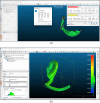Dimensional accuracy of 3D-printed surgical cutting guides after hospital sterilization: a comparative evaluation of ten MEX materials
- PMID: 40748561
- PMCID: PMC12317548
- DOI: 10.1186/s41205-025-00291-w
Dimensional accuracy of 3D-printed surgical cutting guides after hospital sterilization: a comparative evaluation of ten MEX materials
Abstract
Background: Integrating 3D printing into orthopedic oncology enables the development of patient-specific cutting guides for specific anatomy. To preserve surgical precision, especially in tumor resections where the safety margins must balance minimization of recurrence with avoidance of excessive bone removal, it is critical to maintain the dimensional accuracy of these guides throughout all stages of fabrication, disinfection, cleaning, and sterilization.
Methods: Personalized cutting guides were 3D printed using ten filaments, and 3D scanned before and after sterilization. Two sterilization methods were used: autoclave and vaporized hydrogen peroxide. Dimensional deviations were assessed by comparing the reference STL model with the scanned models using metrics such as root mean square, standard deviation, Gaussian mean, and maximum error. Pearson correlation analysis was conducted to evaluate inter-sample variability and metric interdependence.
Results: PLA and PETG showed the best dimensional accuracy in the as-printed state with RMS values of 0.093 mm and 0.093 mm, respectively, and standard deviations below 0.092 mm. After hydrogen peroxide sterilization, PETG, PC, and PETG-CF kept a high accuracy, while PLA, PLA-HP, PA, and PA6-CF showed significant deformations. Autoclave sterilization determined severe deformation in most materials, with PC showing unexpectedly changes of the geometrical form, increasing in RMS error from 0.127 mm to 3.642 mm. In the as-printed state, maximum error remained below 0.29 mm for all materials, with PLA having the highest localized deviation (0.283 mm). After hydrogen peroxide sterilization, PETG, PC, and ABS maintained maximum error values lower than 0.27 mm, while PLA increased to 0.274 mm and PLA-HP to 0.268 mm. These values, although moderate, showed geometric changes that affect fit in anatomically constrained regions. Pearson correlation analysis showed that hydrogen peroxide sterilization altered the relationship between accuracy metrics of prints after manufacturing, weakening the correlation between RMS and Gaussian mean. This suggested increased unpredictability in deformation direction and highlighted less consistent deformation patterns.
Conclusions: Disinfection and sterilization processes were highly material-dependent, as expected. PETG, PC, and PETG-CF were the most stable materials for the 3D-printed surgical guides when using cold plasma sterilization. Materials like PLA, PLA-HP, and PA require caution due to their instability. Designers should take into account the deformation directionality loss post-sterilization and integrate fit allowances into surgical guide geometry.
Keywords: 3D printing; Dimensional accuracy; MEX; Orthopedic oncology; Sterilization; Surgical guides.
© 2025. The Author(s).
Conflict of interest statement
Declarations. Ethics approval and consent to participate: This study was approved by the ethical review committee of Colentina Clinical Hospital, no. 13/2025. Consent for publication: Obtained from patient. Competing interests: The authors declare no competing interests.
Figures












Similar articles
-
Distortion of printed resin surgical guides after autoclave sterilization and chemical disinfection.J Prosthet Dent. 2025 Jul;134(1):187.e1-187.e7. doi: 10.1016/j.prosdent.2025.02.052. Epub 2025 Mar 20. J Prosthet Dent. 2025. PMID: 40113529
-
Comparison of Dimensional Accuracy and Stability of 3D-Printed, Computer-Aided Design/Computer-Aided Manufacturing (CAD/CAM), and Conventional Polymethyl Methacrylate (PMMA) Denture Base Materials: An In Vitro Study.Cureus. 2025 May 31;17(5):e85128. doi: 10.7759/cureus.85128. eCollection 2025 May. Cureus. 2025. PMID: 40599505 Free PMC article.
-
Effect of different storage conditions on dimensional accuracy of 3D-printed dental models.J Prosthodont. 2025 Jul;34(6):617-625. doi: 10.1111/jopr.13834. Epub 2024 Feb 26. J Prosthodont. 2025. PMID: 38409924
-
Guided tissue regeneration for periodontal infra-bony defects.Cochrane Database Syst Rev. 2006 Apr 19;(2):CD001724. doi: 10.1002/14651858.CD001724.pub2. Cochrane Database Syst Rev. 2006. Update in: Cochrane Database Syst Rev. 2019 May 29;5:CD001724. doi: 10.1002/14651858.CD001724.pub3. PMID: 16625546 Updated.
-
Management of urinary stones by experts in stone disease (ESD 2025).Arch Ital Urol Androl. 2025 Jun 30;97(2):14085. doi: 10.4081/aiua.2025.14085. Epub 2025 Jun 30. Arch Ital Urol Androl. 2025. PMID: 40583613 Review.
References
-
- Mustahsan VM, Helguero CG, He G, Komatsu DE, Hansen D, Pentyala S, Kao I, Khan F. 3D-printed guides in bone tumor resection: studying their error and determining a safety margin for surgery. Orthopedics. 2022;45:169–73. 10.3928/01477447-20220217-05. - PubMed
-
- Dong C, Beglinger I, Krieg AH. Personalized 3D-printed guide in malignant bone tumor resection and following reconstruction – 17 cases in pelvic and extremities. Surg Oncol. 2022;42:101733. 10.1016/j.suronc.2022.101733. - PubMed
LinkOut - more resources
Full Text Sources
Research Materials
Miscellaneous
